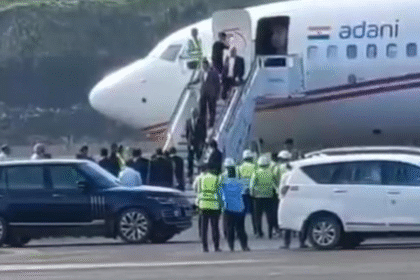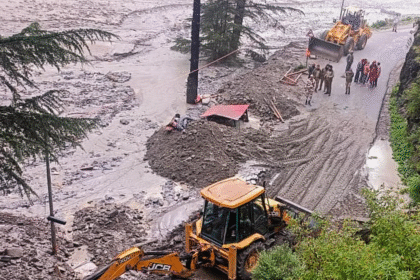Mumbai rains: Water levels in city’s seven reservoirs reach 26.84 per cent
Mumbai rains boost water levels in city’s seven reservoirs to 26.84%, offering some relief amid ongoing monsoon season concerns
The water levels in lakes supplying drinking water to Mumbai have risen following heavy rainfall in their catchment areas. According to Brihanmumbai Municipal Corporation (BMC) data, the combined stock in the seven reservoirs that provide water to the city now stands at 26.84 per cent.
As per BMC records on Sunday (June 22), the collective water stock in these reservoirs is 3,88,523 million litres, which amounts to 26.84 per cent of their total capacity.
The BMC supplies drinking water daily from Upper Vaitarna, Modak Sagar, Tansa, Middle Vaitarna, Bhatsa, Vihar, and Tulsi lakes.
Of these, Tansa has 9.99 per cent water stock, Modak Sagar 44.22 per cent, Middle Vaitarna 25.03 per cent, Upper Vaitarna 31.04 per cent, Bhatsa 21.79 per cent, Vehar 39.71 per cent, Tansa 29.13 per cent and Tulsi 38.33 per cent.
Lower (Modak Sagar), Middle and Upper Vaitarna lakes, along with Tansa, supply water to the western suburbs from Dahisar Check Naka to Bandra and to the western parts of the city from Mahim to Malabar Hill.
Bhatsa, Vehar, and Tulsi together form the Bhatsa system. Water from this system is treated at the Panjarpur Water Treatment Plant and distributed to the eastern parts of Mumbai, covering the eastern suburbs from Mulund Check Naka to Sion and further to Mazagaon.

Meanwhile, residents of Mumbai can expect a generally cloudy sky today, with the possibility of intermittent spells of moderate rainfall across the city and its suburbs, according to the latest Mumbai weather updates by the India Meteorological Department (IMD).
The IMD’s Santacruz observatory recorded a maximum temperature of 32.9 degrees Celsius and a minimum of 25 degrees Celsius on Sunday. Meanwhile, the Colaba observatory reported a high of 31.6 degrees Celsius and a low of 26 degrees Celsius, as per the latest Mumbai weather updates.
As per tide predictions, high tide is expected at 9:28 AM with a height of 4.09 meters, followed by low tide at 3:06 PM at 2.09 meters. Another high tide is forecast at 8:52 PM, reaching 3.74 meters.
Additionally, a low tide is expected early tomorrow at 3:25 AM, with the water level dropping to 0.59 meters on June 23, 2025.
Mumbai’s monsoon cranked into gear in late May, but water stocks in the seven main reservoirs supplying the city remain alarmingly low. As of mid‑June 2025, the water storage level stands at just 26.84% of capacity—a worrying sign amid increasing demand and erratic rainfall.

The Indian Meteorological Department (IMD) reported an early onset of the monsoon in Mumbai around May 25, 2025, but the rains since then have underwhelmed in key catchment areas. As per BMC data from June 5:
- Tulsi river area received 78 mm of rain
- Bhatsa basin logged 49 mm
- Middle Vaitarna only 30 mm
- Other lakes—including Vihar, Upper Vaitarna, Modak Sagar, and Tansa—saw between 12–21 mm.
- No measurable rainfall occurred in those regions between June 4–5.
Despite the early arrival, weak rains have severely undercut reservoir replenishment.
As of June 5, reservoirs were holding just 11.77%, which calculates to around 1.70 lakh million litres (ML) out of a total capacity of approximately 14.5 lakh ML. Comparatively:
- June 2024: 6.78% (≈98,182 ML)
- June 2023: 11.58% (≈167,550 ML)
While June’s numbers show some improvement from last year, they remain dangerously low for this stage of the monsoon.
| Reservoir | Useful Content (ML) | % Capacity | Rainfall last 24 hrs (mm) |
|---|---|---|---|
| Modak Sagar | 38,639 | ~26.7% | 4 |
| Tansa | 16,892 | ~25.5% | 5 |
| Vihar | 8,944 | ~24.5% | 8 |
| Tulsi | 2,459 | ~18.2% | 16 |
| Upper Vaitarna | 10,170 | ~15.9% | 0 |
| Bhatsa | 67,046 | ~28% | 5 |
| Middle Vaitarna | 26,225 | ~21.7% | 10 |
Bhatsa holds the highest share (~5.0 lakh ML capacity, 28%), yet still far below full supply.
Upper Vaitarna trails significantly, at under 16% capacity.
Tulsi, despite receiving slightly more rain, still reflects only ~18%.
Though monsoon began early, the most crucial catchment zones have been dry. This has drastically reduced reservoir inflow
Mumbai has witnessed warm pre-monsoon temperatures—intensifying evaporation from exposed water surfaces and soil
Demand has climbed steadily due to population growth and expanded water connections. The stored reserves may not meet the city’s daily needs (~3,800–3,950 ML/day) if inflows don’t pick up soon
In similar low-stock situations during June–July 2024, BMC imposed 5–10% water cuts. If stocks cross critical thresholds (10–15%), cuts were enforced or continued—even amid rain
Past crises have forced BMC to tap into state reserve stock, especially Bhatsa’s reserves. In April 2025, these reserves stood at 30%, used until July to manage shortfalls . With current levels below that, options are limited.
The city experienced dry spells in June–July 2024, leading to sustained water cuts. With current underperformance, Mumbai may repeat that pattern this year .
State officials have previously earmarked 1.79 lakh ML from reserve lakes to support Mumbai. More may be drawn if required.
Ahead of summer 2025, BMC promoted water conservation—urging recycling, rainwater harvesting, and curbing non-essential use .
Older lakes are being rehabilitated—the aim is to reduce leakage, improve storage, and manage runoff better. However, progress remains uneven
Conserve Daily Use: Use rainwater harvesting, reuse water for gardening/car washing, and fix household leaks.
Reduce Demand: Delay non-essential water use during peak summer, avoid overfilling pools, and prioritize essential needs.
Community Actions: Engage local citizen groups working on lake cleanup, groundwater recharge, and green cover
Awareness is Key: Educate neighbours and advocate for building-level rainwater harvesting installations
While IMD issued a yellow alert for light rains in Mumbai around early May, those rain spells haven’t translated into substantial catchment inflows. Unless rainfall picks up dramatically in coming weeks, reservoirs may remain below 40–50% capacity—still inadequate to avert long-term cuts.
Historically:
- By late July 2024, reservoirs rebounded to ~53%, easing cuts .
- By late July 2024, stocks reached ~75% thanks to heavy rains .
The potential remains for the monsoon to deliver a counterbalance—but timing and intensity will determine whether 2025 avoids a crisis.








